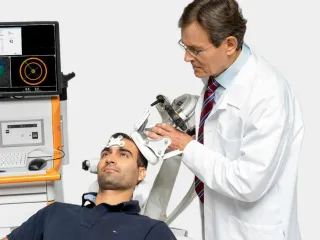The treatment of clinical depression and chronic pain rely heavily on medicine that may cause addiction and undesirable side effects. Together with VTT, Nexstim has been developing algorithms that support the medical stimulation of the brain. As a result, various medical conditions can be treated with targeted brain stimulation instead of medicine.
Key facts
Reduces dependence on medicine
Enables targeted and effective medical treatment
Improves locating and visualising brain anatomy and target areas
Nexstim is a personalized neuromodulation company that develops pioneering targeted brain stimulation systems for both therapeutic and diagnostic applications. Founded in 2000, Nexstim strives to be the new standard of care for treating a host of currently intractable brain diseases and disorders.
Brain stimulation requires accurate location data
Currently diseases such as clinical depression and chronic pain are still mainly treated with drugs. The drugs affect the whole human body and may have multiple side effects. These treatments are sometimes successful but on the whole not very effective. Brains stimulation has shown in controlled trials higher effectiveness and it is targeted to only small areas of the brain with very little side effects if any.
Many mental disorders or chronic pain, for example, can be treated locally by stimulating small areas of the brain. The challenge lies in being certain that you are stimulating exactly the right area. The brain has well defined functional areas and affecting the wrong one may result in inefficient or full lack of treatment effect. This is why mapping the brain as accurately as possible is key in medical brain stimulation.
Science has to some extent analysed the interaction between the different parts of the human brain and body. However, each person's brain is structurally unique and should be treated accordingly.
To improve, automate and visualise the treatment location determination process required for effective brain stimulation, Nexstim needed a partner with a profound knowledge of mathematical models and software development. As we already had a good existing partnership with Nexstim spanning several years, we were asked to join the project.
Machine-learning improves image registration
Locating the exact area where the patient should be stimulated requires the alignment of an MRI of the patient’s brain and a generic atlas containing the information of the different areas of the brain. This process is called image co-registration.
Co-registering a unique brain and a generic model representing an average brain automatically required us to develop and validate advanced algorithms that function seamlessly with Nexstim’s software. To overcome the challenge, we had to combine our expertise in machine-learning, cutting-edge mathematical models and software development.
It’s hard enough to find an algorithm developer with a strong know-how in medical applications. I still think that VTT’s biggest strength is their versatility. VTT can flexibly assemble a team that covers all the areas needed for a challenging R&D project.
Our ambition is to apply our scientific knowledge to solve our customer’s demanding practical problems. Working in agile cross-disciplinary teams featuring both data scientists as well as software and hardware developers combined with a deep understanding of the healthcare domain are crucial to our success.
The project optimised the co-registration process, allowing doctors to correlate the complex structural characteristics of the human brain and to visualise the areas they should treat for a certain effect.
Targeted brain stimulation replaces regular medication
Brain stimulation has various medical uses where the treatment yields significant patient benefits. These include the treatment of:
- Clinical depression
- Brain tumour resection
- Chronic pain
- Tinnitus (early studies show possible benefits).
In the case of, for example, clinical depression and chronic pain, accurate brain stimulation treatment can free patients from prolonged dependence on medicines. Many medicines designed for the treatment of severe medical states or pains can have significant side effects and cause addiction. In some cases, a series of stimulation sessions can replace regular medication altogether. The treatment thus becomes more targeted and less dependent on chemicals.
For brain surgeries, the correlation of an MRI and a brain atlas helps the clinician to define the areas where to operate. This way the decision-making regarding the right treatment becomes more accurate and data driven.
A successful collaboration is based on trust
The partnership between us and Nexstim has lasted for over a decade and covered various projects from hardware to software development.
Kohtamäki believes that flexibility and creativity are at the heart of a good customer relationship: “With Nexstim, we both know that the lines of communication are always open. You can call whenever you need to if you get an idea that might benefit a project. That is only possible when there is mutual trust between the partners.”
It’s important that you have the courage and trust to toss ideas around, try them and possibly even fail together. Learning from those experiences usually creates something fruitful and new. This is where VTT excels. Over the years we have created a bond that lasts.
“We truly appreciate long-term collaborations and Nexstim has always been a fair and enjoyable partner. We always enjoy helping our customers develop excellent products, services and processes for better health and wellbeing,” Kohtamäki concludes.
The cooperation on image analytics is set to continue. Our diverse offering has the potential to benefit Nexstim on a large scale, and we’re more than willing to showcase that in the future.








